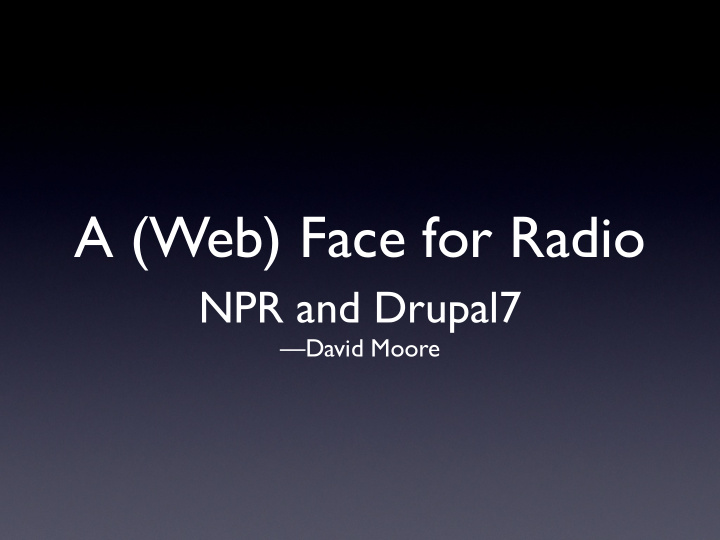



A (Web) Face for Radio NPR and Drupal7 —David Moore
Who am I? • David Moore • Developer at NPR • Using Drupal since 4.7 • Focus on non-profit + Drupal • CrookedNumber on drupal.org, twitter, etc.
What is NPR? • A non-profit provider of content and services for public radio • Your local station? Totally independent — but likely buys stuff from NPR (and others) • Digital Services division based in Boston, provide web services like ....
Core Publisher • A platform based on Drupal7 • Turn-key solution for public radio stations • Focus on news and programming • Ultimate aim is to provide almost everything a station needs
The People • 5 drupal devs; 2 front-end (dedicated) • Also: one product owner; one analytics; 4 designers; 3 sysadmins • Until recently, was much smaller. Included an Acquia “embed” contractor. • We’re still hiring!
The hardware • Huge web box X 6 • One ‘metric ton’ of RAM • Varnish X 2 • MySQL X 2 • GSA X 2 • Massive isilon machine for files • Nagios for monitoring
Extreme Makeover • Quick win • Gets attention of everyone: from interns to GM • Sets a tone -- but also sets the bar
Without CP
With CP
Life on the Bleeding Edge • Started with 7 alpha 3 • Had to preserve data from alpha to alpha • Thanks to head_head and alpha_2_alpha • Able to brag that we were on 7.0 the day it was released.
Is it worth it? • Shifting API • Lack of docs • Tech debt is much worse; lots of hacks • You get to know the product very early in dev cycle • Don’t have to worry about upgrading for 2 (?) years
What’s under the hood? • Based on an install profile (much easier in 7). • One big multi-site install • More like a web app — providing uniform experience • Lots of custom code; a few contrib • One mother theme, with small tweaks at station level.
The Gold Config • Following a command to be “prescriptive” and keep things consistent and uniform • We nail everything down to an install profile • Lots of config goes into a “gold” include file • All the stuff that can get messed up: roles, users,WYSIWYG, content types, etc.
Lots of Custom Code • Existing modules weren’t ready for D7 • Needed specific code (e.g., for NPR API) • Needed a “prescriptive” UI, adding abstraction layer on top of more complicated Drupal UI
NPR API • Pulls down syndicated story • Stores data in shared DB outside of drupal • Some basic curation tools • NPR stories -- but on your local station site, in its chrome
Ingest • Local station stories are automatically sent to the NPR API • So (the theory is) local stories go national.
Menus • A ‘category menu‘ — add a taxonomy term, it’s automatically added to menu • A menu based on ‘table queue’ (like node queue, but more flexible) • Abstraction layer — stations don’t have to mess with menus admin
Content Types • Pretty basic: post, person, page, program • All built on install via custom exportables module • Can be rebuilt on update -- via our old friend, gold config
Layout • A panels-lite engine, again based on table queue • Lots of text, no graphics • Simple, hard to break — but plain
Ads • Basic DoubleClick for Publishers integration • Another simplifying abstraction layer (stations don’t touch blocks admin page)
Analytics • Simplified version of Google Analytics module • Again, to simplify UI (for NPR Client Services)
Search • Google Search Appliance (gulp!) • Modified the GSA module — to hard code values, allow for GSA feeds • In the future, more abstraction layers to tweak search results via drupal admin GUI • Also: a PHP/drupal layer for GSA Admin API
The River • A/k/a - “Budget views” • Simple reverse-cron view • Faster • But no GUI (feature, not a bug)
Cache Rules Everything • Varnish is great, but a beast to configure • Look into “saint mode” — for DB updates • We use drupal cache and APC too • Custom module clears varnish and drupal caches at CUD node operations • Other modules can leverage it
Content Migration • Wordpress (.sql dumps) to drupal 7 • Legacy content (.csv dumps) to drupal 7 • Learn how to write a drush command. It’ll change your life.
Code Push • All via one big drush script • Puts all sites in maintenance mode • Pushes code via SVN to six servers • Runs updates • Pause for smoke test • Take all sites out of maintenance mode
It’s Ok to Hack Core ... if an Acquia engineer says it’s OK
Hungry like the Wolf • A drush script that “fixes everything” • Keyed by hooks within modules • Causes a module to perform certain actions, depending on its environment: local, stage or production • Still experimental
Running this All • OMNI • Essentially an Aegir lite • Has its own install profile • Handles SVN pushes, migrations, site creation — all through a GUI
But wait!! There’s more • Real-time playlist updates • Content lock • A drafts system (see Wordpress) • A blame tracker (“every form submit by every user”)
Giving Back • ~10 patches to core • ~12 patches to contrib • More substantive stuff on the way • http://drupal.org/project/npr • As well as several other modules
Lessons Learned • Non-paying, pilot customers are no less demanding (not necessarily a bug) • Make it look good. Early. • Write custom code. Just never as a first resort. • Abstraction layers are your friend. • Install profiles can be very powerful.
Questions?
Thanks!! • NPR: dmoore@npr.org • Drupal: crookednumber.com • Twitter: @CrookedNumber
Recommend
More recommend